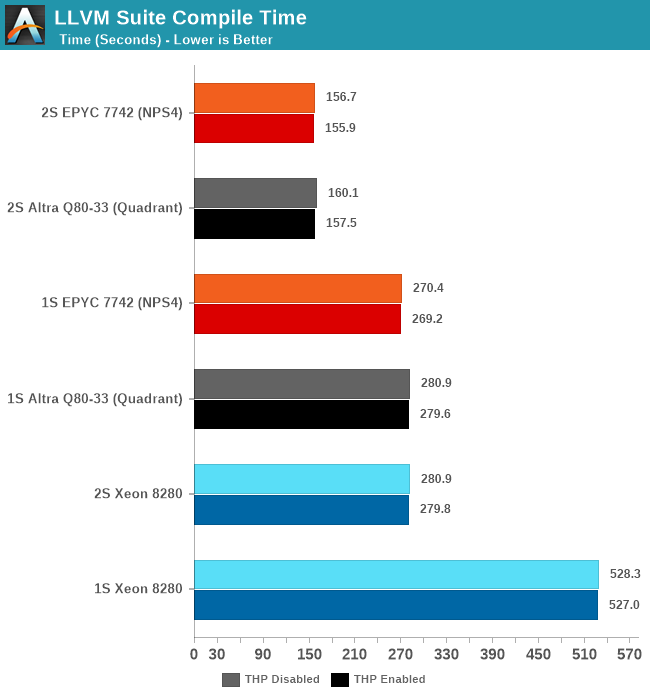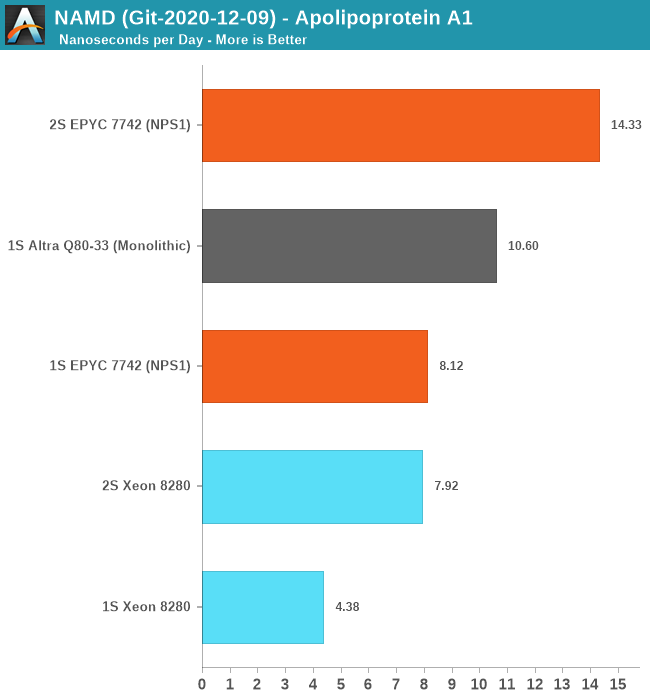The Ampere Altra Review: 2x 80 Cores Arm Server Performance Monster
by Andrei Frumusanu on December 18, 2020 6:00 AM EST- Posted in
- Servers
- Neoverse N1
- Ampere
- Altra
Compiling LLVM, NAMD Performance
As we’re trying to rebuild our server test suite piece by piece – and there’s still a lot of work go ahead to get a good representative “real world” set of workloads, one more highly desired benchmark amongst readers was a more realistic compilation suite. Chrome and LLVM codebases being the most requested, I landed on LLVM as it’s fairly easy to set up and straightforward.
git clone https://github.com/llvm/llvm-project.gitcd llvm-projectgit checkout release/11.xmkdir ./buildcd ..mkdir llvm-project-tmpfssudo mount -t tmpfs -o size=10G,mode=1777 tmpfs ./llvm-project-tmpfscp -r llvm-project/* llvm-project-tmpfscd ./llvm-project-tmpfs/buildcmake -G Ninja \ -DLLVM_ENABLE_PROJECTS="clang;libcxx;libcxxabi;lldb;compiler-rt;lld" \ -DCMAKE_BUILD_TYPE=Release ../llvmtime cmake --build .We’re using the LLVM 11.0.0 release as the build target version, and we’re compiling Clang, libc++abi, LLDB, Compiler-RT and LLD using GCC 10.2 (self-compiled). To avoid any concerns about I/O we’re building things on a ramdisk – on a 4KB page system 5GB should be sufficient but on the Altra’s 64KB system it used up to 9.5GB, including the source directory. We’re measuring the actual build time and don’t include the configuration phase as usually in the real world that doesn’t happen repeatedly.

The Altra Q80-33 here performs admirably and pretty much matches the AMD EPYC 7742 both in 1S and 2S configurations. There isn’t exact perfect scaling between sockets because this being a actual build process, it also includes linking phases which are mostly single-threaded performance bound.
Generally, it’s interesting to see that the Altra here fares better than in the SPEC 502.gcc_r MT test – pointing out that real codebases might not be quite as demanding as the 502 reference source files, including a more diverse number of smaller files and objects that are being compiled concurrently.
NAMD
Another rather popular benchmark tool that we’ve actually seen being used by vendors such as AMD in their marketing materials when showcasing HPC performance for their server chips is NAMD. This actually quite an interesting adventure in terms of compiling the tool for AArch64 as essentially there little to no proper support for it. I’ve used the latest source drop, essentially the 2.15alpha / 3.0alpha tree, and compiled it from scratch on GCC 10.2 using the platform’s respective -march and -mtune targets.
For the Xeon 8280 – I did not use the AVX512 back-end for practical reasons: The code which introduces an AVX512 algorithm and was contributed by Intel engineers to NAMD has no portability to compilers other than ICC. Beyond this being a code-path that has no relation with the “normal” CPU algorithm – the reliance on ICC is something that definitely made me raise my eyebrows. It’s a whole other discussion topic on having a benchmark with real-world performance and the balance of having an actual fair and balanced apple to apples comparison. It’s something to revisit in the future as I invest more time into looking the code and see if I can port it to GCC or LLVM.

For the single-socket numbers – we’re using the multicore variant of the tool which has predictable scaling across a single NUMA node. Here, the Ampere Altra Q80-33 performed amazingly well and managed to outperform the AMD EPYC 7742 by 30% - signifying this is mostly a compute-bound workload that scales well with actual cores.
For the 2S figures, using the multicore binaries results in undeterministic performance – the Altra here regressed to 2ns/day and the EPYC system also crashed down to 4ns/day – oddly enough the Xeon system had absolutely no issue in running this properly as it had excellent performance scaling and actually outperforms the MPI version. The 2S EPYC scales well with the MPI version of the benchmark, as expected.
Unfortunately, I wasn’t able to compile an MPI version of NAMD for AArch64 as the codebase kept running into issues and it had no properly maintained build target for this. In general, I felt like I was amongst the first people to ever attempt this, even though there are some resources to attempt to help out on this.
I also tried running Blender on the Altra system but that ended up with so many headaches I had to abandon the idea – on CentOS there were only some really old build packages available in the repository. Building Blender from source on AArch64 with all of its dependencies ends up in a plethora of software packages which simply assume you’re running on x86 and rely on basic SSE intrinsics – easy enough to fix that in the makefiles, but then I hit some other compilation errors after which I lost my patience. Fedora Linux seemed to be the only distribution offering an up-to-date build package for Blender – but I stopped short of reinstalling the OS just to benchmark Blender.
So, while AArch64 has made great strides in the past few years – and the software situation might be quite good for server workloads, it’s not all rosy and we’re still have ways to go before it can be considered a first-class citizen in the software ecosystem. Hopefully Apple’s introduction of Apple Silicon Macs will accelerate the Arm software ecosystem.










148 Comments
View All Comments
mode_13h - Monday, December 21, 2020 - link
I agree that people should do a sanity-check on their numbers.Spunjji - Monday, December 21, 2020 - link
"This thing is quite big."Package size is not die size.
If Nvidia can pump out dies more than twice the area on an inferior process and still get some perfect dies, I suspect they'll have no issues whatsoever with yield on TSMC 7nm at this stage - especially with the ability to sell lower-core-count variants.
Samus - Sunday, December 20, 2020 - link
Die harvested models with less cores sell for only 5-10% less. So I'm not sure if that means yields are really good, or really bad. Apparently they seem to be pushing the 80 core models pretty hard since so many are being offered.Then again, it depends what we define as yield quality? Defects seem to be low, but binning could be another issue as only two models seem to hit 3.3GHz and at incredibly high power budgets.
Spunjji - Monday, December 21, 2020 - link
3.3Ghz is about where that architecture tops out - I'm not sure that tells us much about yield. To me, the pricing seems to indicate that they aren't expecting to have to shift a ton of the lower-core-count die-harvested models.damianrobertjones - Friday, December 18, 2020 - link
Assuming that Intel just wants to milk customers forever, just like nVidia/phone oems do, they should quickly bridge the performance gap. They'll just have to stop being lazy and actually provide us with more than a drip fed speed increase.fishingbait - Friday, December 18, 2020 - link
An Apple guy I see. Remember that up until a couple of months ago Apple was charging you $1000 for a laptop with a dual core 1.1GHz chip.The "phone OEMs" finally have a core that can somewhat compete with Apple's Firestorm. It will take them a couple iterations to perfect it but they are on the right path. As for Intel, another story entirely. The latest word is that their 10nm process isn't going to well and they have hit yet another delay for 7nm. They may hit up Samsung's foundries just to get a product out (due to TSMC not having any capacity until December 21). So while their issues are far more significant than those for Android phones, it isn't due to their lazily milking customers. They have real tech issues to deal with, issues of the sort that Apple and AMD don't have to worry about because they lack the capability and expertise required to make their own chips.
mode_13h - Sunday, December 20, 2020 - link
> because they lack the hubris to think they should try to make their own chips.Fixed that for you.
Spunjji - Monday, December 21, 2020 - link
"So while their issues are far more significant than those for Android phones, it isn't due to their lazily milking customers."Correct, their technical issues are entirely separate from their strategy of lazily milking customers.
Ridlo - Friday, December 18, 2020 - link
While no Blender test is indeed a bummer, did you guys tried testing with other ray tracing application (LuxMark, C-Ray, Povray, etc.)?Andrei Frumusanu - Friday, December 18, 2020 - link
I didn't have a standalone test, but Povray is part of SPEC.